Introducing 'WiFi Controls' to the new EE app
Product & Content Design, Research, Art Direction, Vendor Management, Stakeholder ManagementBackground
In early 2022, I led a small team of four Designers (both Product and Content Design) in re-imagining a service that enables new broadband customers to set up their hardware (known as a 'Smart hub') and take charge of broadband connectivity in their homes. The 'WiFi controls' service would play a critical part in the launch of a brand-new EE app due to be released to the market in February 2023 that would combine both BT and EE consumer services into one place.
The challenge
Firstly, the average household uses over 20 apps to manage different aspects of their home from heating, security, lights, shopping, entertainment, and more. It's confusing and time consuming for everyone and this ecosystem is only getting larger and more complicated to manage daily.
Secondly, very few BT customers understand how to initially set up their hardware (the 'Smart hub 2') to get online and then use their hardware effectively to take charge of the connection in their homes which costs BT millions of pounds annually in customer support calls alone.
Lastly, the existing 'Smart hub 2' (which serves as the most common hardware currently used across the BT consumer network) capabilities are very limited. The 'Smart hub 2' is unable to identify device information or run advanced diagnostics on your connection if there's an issue.
The opportunity
New, upcoming 'Smart hub 3' technology, BT's strategic ambition to join both the BT and EE consumer brands together, and BT's national broadband network mean that we have a unique opportunity to consolidate both the BT and EE consumer apps into one, improve the hardware setup and device control experiences for customers and help the company realise new commercial opportunities through add-ons (gaming, boosting bandwidth) and personalised recommendations.
Current 'Smart hub 2' setup & device control experiences
The current setup experience for 'Smart hub 2' consumers (done through the BT app) is long and requires a lot of steps.

Current experience for setting up a new smart hub

Current experience for controlling your devices in your home
Top-level performance metrics for the existing journey (setup and device control)
- 12.2% 'Smart hub 2' setup completion in the BT app
- 0.2% create a group of devices in the BT app
- 4% 'pause their wifi' to a device in their home
- 0.7% share their smart hub password through the BT app
- 9.6% set up for parental control content restrictions for devices in their homes
Digging deeper into the problem space
To help us better understand the mindsets and intentions of our audience, we interviewed 20 people (16 of whom we would consider as 'tech savvy') who were both new and existing BT customers with active broadband accounts.
We discovered that:
- 19/20 didn't use the BT app to set up their 'Smart hub 2' (they called instead)
- Most participants said they use the BT app for checking bills once and rarely come back to use it again throughout the month
- 19/20 said it'd be useful for them to quickly block harmful content on their family's devices
- People generally found paper instruction easier to follow than using the BT app
- Most people do run a speed test on their connection when it's down but they use Google not the BT app
- 16/20 said they would expect to control 3rd party devices (Google Doorbell) through the BT app
What our customers are saying to us
- Customers didn't trust the BT app to setup their new hardware
- Customers generally find it easier to call our customer support team for help setting up their new hardware
- Customers didn't think of the BT app as a tool that could help make their lives easier in their homes
- Setting up our hardware is difficult for less tech-savvy customers
- Customers would value the ability to control all of the devices in their homes in one place
Defining a product & market fit
We used the value proposition canvas to help us ensure that our product and service were positioned around what our customers want and need and that there was a good 'fit'. We identified our customer's pains, gains, and jobs to be done together with respective gain creators, pain relievers, and products and services.
Our new app will transform our customer's digital home experience. It lets our customers easily set up new hardware and control their new and existing devices and services in one app. It'll also help to protect the household online, prioritise bandwidth for the very best gaming and working-from-home connectivity, plus give personalised recommendations for new products and services, based on their behaviour and daily activity.

First ideation phase
As we began our ideation, BT had publicly shared their ambition to combine their two consumer brands (BT and EE) into one - giving all of their BT and EE customers their best products and offerings in one place (one bill, one app, and a single view of our customers).



The new EE brand would launch in October 2023 as the single consumer division for BT Group
We began generating ideas using the crazy 8 format together with the team, stakeholders, and subject matter experts across the company. We dot- votted on the ideas that resonated the most with the group and brought those ideas into refinement.



Here were some of the standout themes we explored:
- Reduce steps in setup and use more practical and interactive gifs/videos to help users to get their hardware online
- Seamlessly create groups for devices in the household
- Pause WiFi to specific devices using a toggle
- Quick share wifi credentials through the app with friends and family using QR codes
- Change the level of content restriction (parental controls) using a slider
- Personalise recommendations for better hardware to improve user's connectivity and upsell new products and services
- More friendly, human-centric language
- Boost your wifi connection to specific devices
First draft prototypes
We built our prototypes focusing on three distinct areas of the WiFi controls experience; setup, use, and fix.
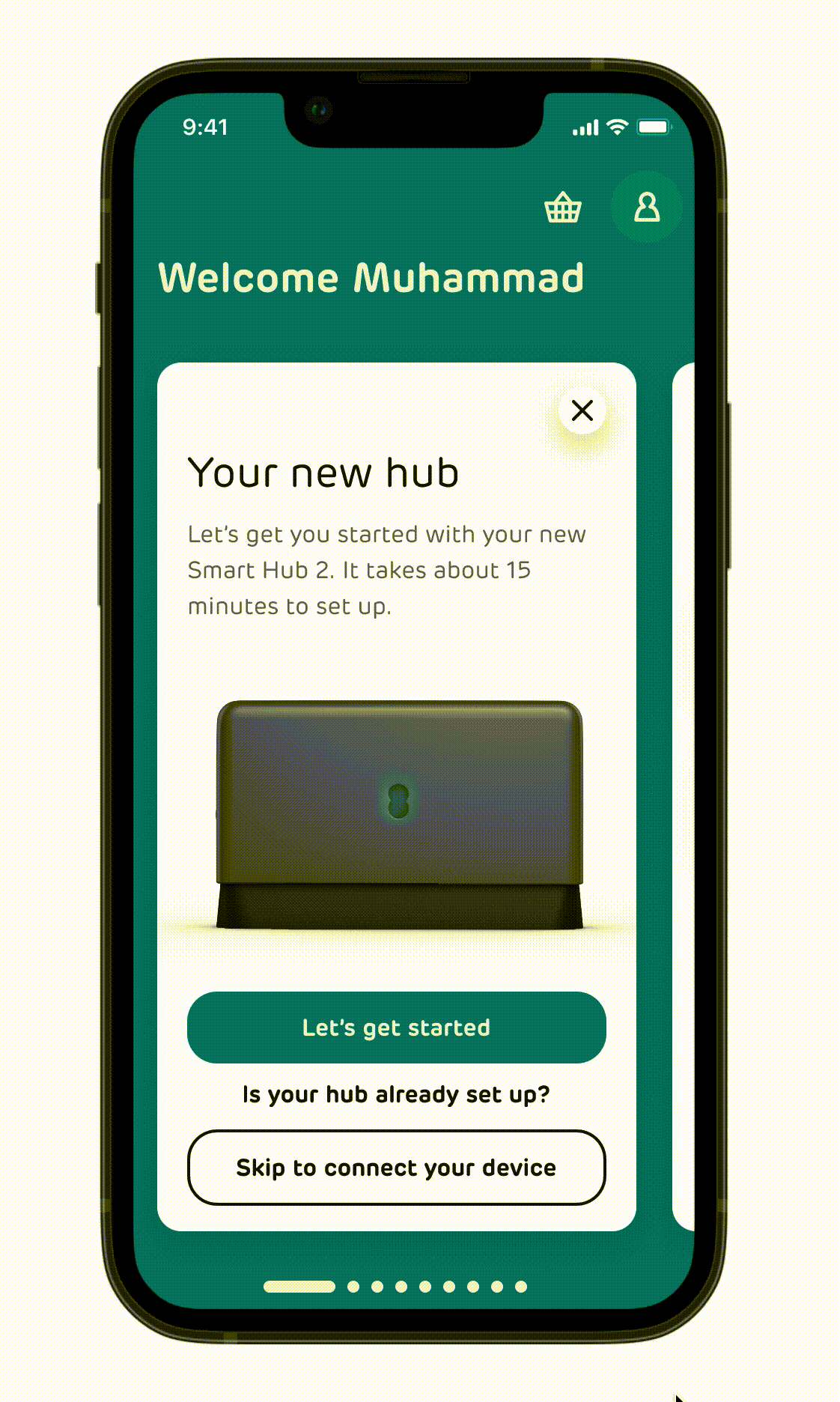
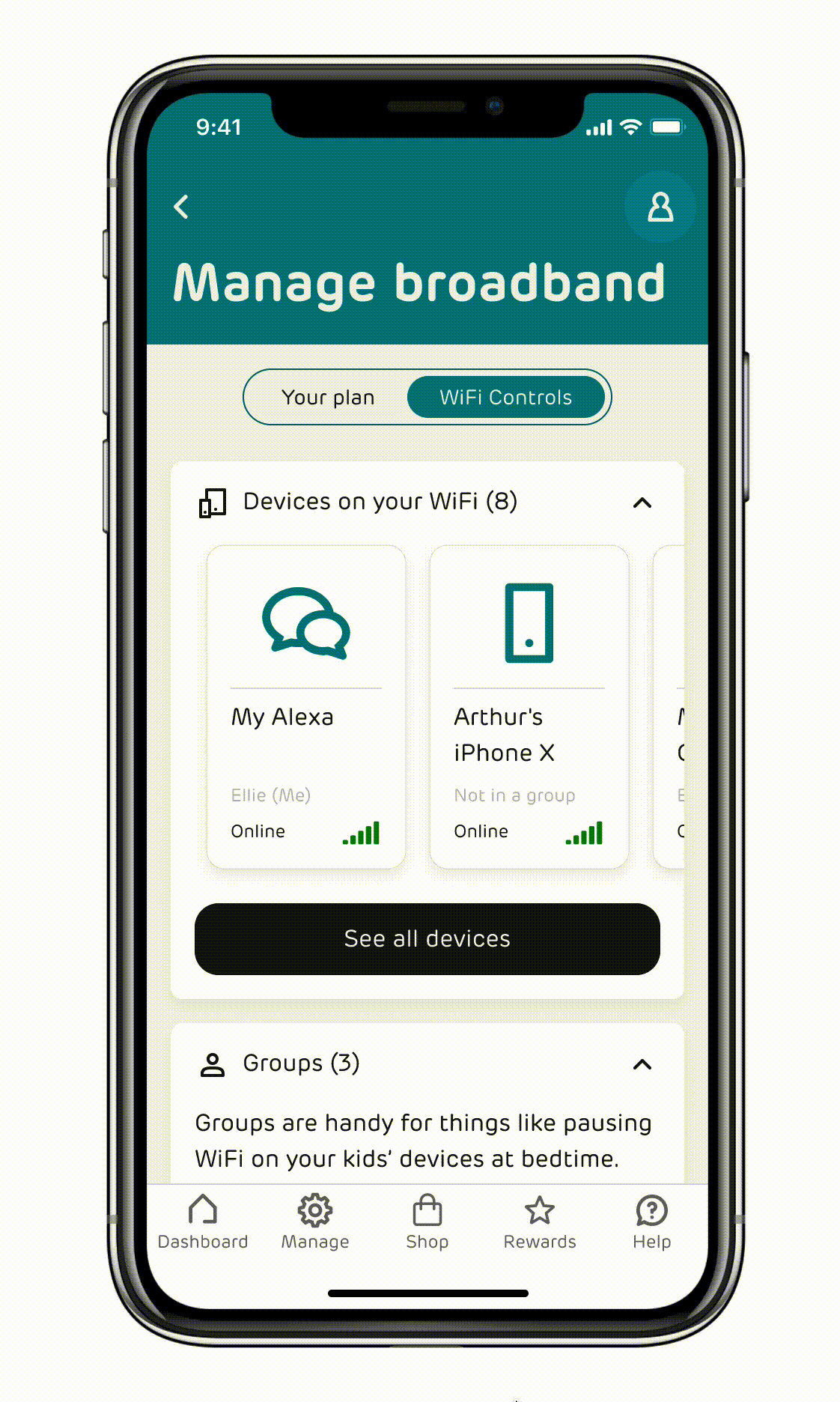
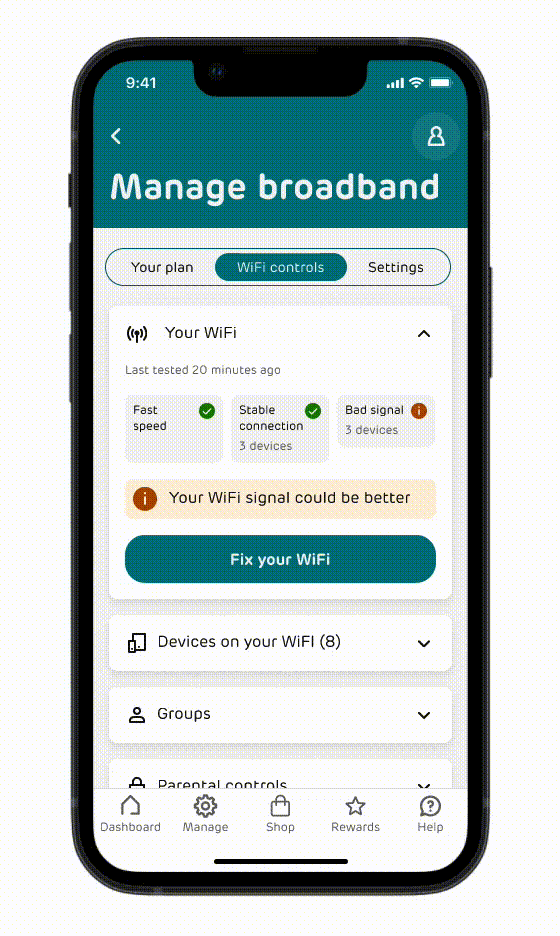
Usability testing our first draft ideas
Using the EES framework (Effectiveness, efficiency, and Satisfaction) we tested our first solutions with 20 participants who were both new and existing BT/EE broadband customers.
Effectiveness - 45% (did the user pass or fail their task?)
Efficiency - 40% (how well could they complete their task?)
Satisfaction - 2 (out of 7) (how satisfied were they with the proposed experience?)
Overall, our first solution didn't test well. The cognitive load was too high, it lacked personality and fun and we weren't explaining why these features are useful to our customers.
Presentation to the BT board and Senior Leadership
After initial usability testing, I presented our first draft prototypes and insights to senior leadership (including our CEO, Marc Allera).
I focused the group's feedback on three things:
- Ambition: Does this prototype match our ambition appropriately?
- Authenticity: Does this feel like the new EE brand?
- Ease of use: Does this feel like an intuitive experience?


The feedback from the group reflected our first round of usability testing; it wasn't ambitious enough! The general consensus was that we had largely re-designed what we have today, which wasn't what we needed.
Second ideation phase (going back to the drawing board!)
We needed to be more ambitious in our thinking so it was back to the drawing board for the team.
We felt we needed to push harder on the capabilities that the 'Smart hub 3' technology could give us; much richer information on each device in the household, more advanced diagnostics, and the ability to boost bandwidth to specific devices to name a few.
What's more, at this time, our new EE consumer brand style guide had been shared and was ready to use in a new digital space. This gave us the confidence, freedom, and permission to experiment with a more daring experience for WiFi controls.

The new EE style guide was fun, experimental, and modern
I facilitated several generative ideation workshops with the team over a two-week period where we began to think more ambitiously - we doubled down on the use of micro-interactions that enabled our user's to boost their bandwidth connection to suit their needs, group devices, fix their wifi connection, enable safe search, recommend personalised upgrades, and much more.



We embraced the new branding style, and cleaned up the visual hierarchy of each page with better use of type, iconography, and horizontal scrolling.

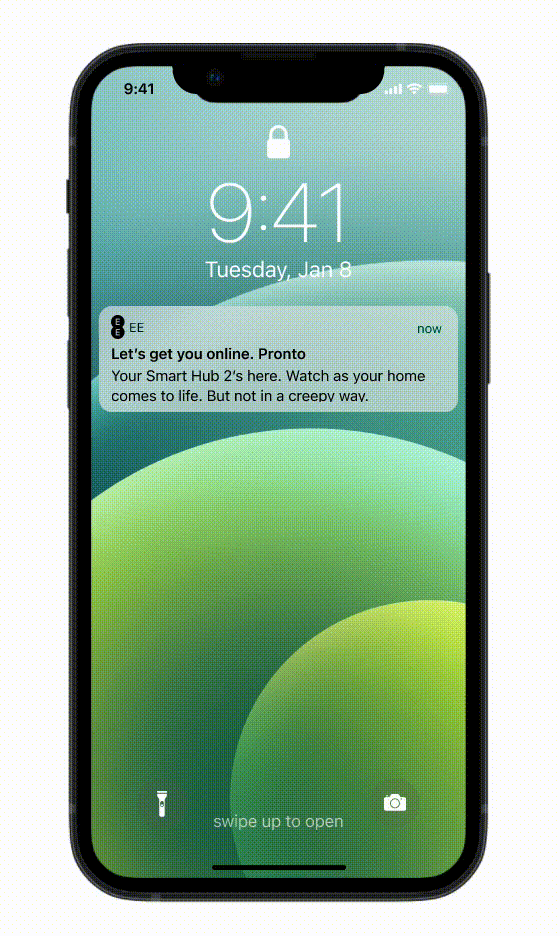

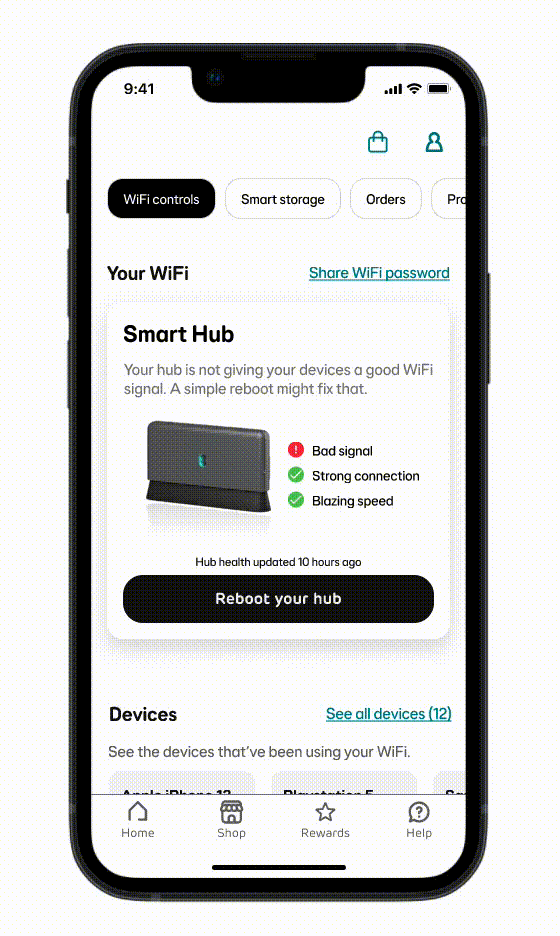
Our second round of ideation felt like night and day from where we had started. We adopted the use of our new EE brand which we thought looked great, we used a more playful tone of voice with animations to help make the experience feel more Interactive and fun and, finally, we were also more purposeful with the content … explaining why these features are useful.
Usability testing our second-round ideas
We kept the sample size the same at 20 and much like the first test these were a mix of new and existing BT/EE customers with broadband.
Effectiveness - 95% (up 111.1%)
Efficiency - 85% (up 112.5%)
Satisfaction - 6(out of 7) (up 200%)
Some key themes emerged from this round of testing;
- Our new tone of voice resonated with our intended younger audience
- Customers didn't think of long press as an interactive pattern
- The hierarchy of content was easy to understand and didn't overwhelm the customer
We hoped that the long-press interaction would become more habitual over time once the user realised it was there.
To market!
Our product launch was planned to spread across three phases with a progressive rollout (starting with an alpha and then moving to a progressive open beta rollout) to ensure that we're actively learning about our customer's behaviour and adapting our solution as we go.

Ahead of the launch, the WiFi controls service was featured in a range of above-the-line marketing materials including this national TV campaign below. It was a real moment for us all in the team to see our work on the big screen!
The results
(Febrary 2023 to June 2023)
- 266% reduction in customer support calls associated with 'getting your hub online'
- 92.3% 'Smart hub 3' setup completion in the new EE app (up 656.5%)
- 61.9% 'pause their wifi' to a device in their home (up 1447.5%)
- Over 6M active users of 'WiFi controls' features (grouping devices, parental controls, wifi boosting)
- 10M+ App downloads (for Android alone)
- Average app rating of 4.6/5 (iOS) and 3.2/5 (Android)
- Secured over £2M in additional investment for 22/23 FY to grow the team
The bit I'm most proud of ...
Our work and tireless efforts in making WiFi controls the best digital experience it could be for the new EE app launch in 2023 were featured heavily at the annual BT Consumer Live conference in 2022 as an example for the entire BT Group of what brilliant digital experiences should look like. Wow!!
Without a great team culture, trust, radically candid feedback, and an authentic leadership style, the team and I would not have been able to achieve this.
My proudest moment at BT by far!





